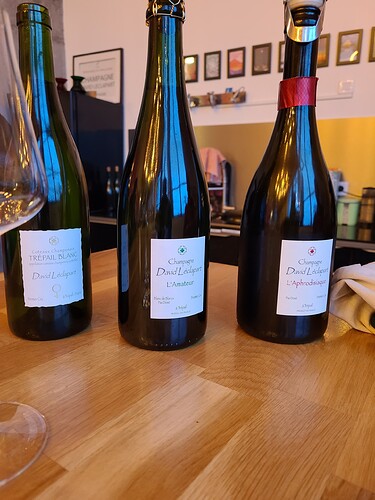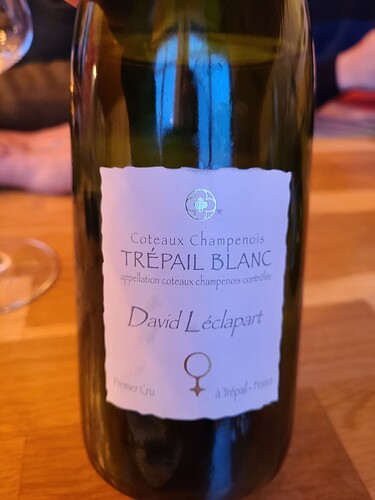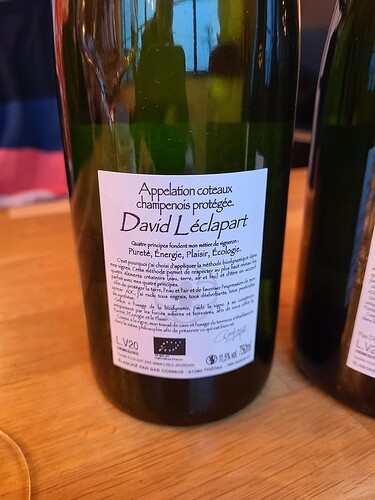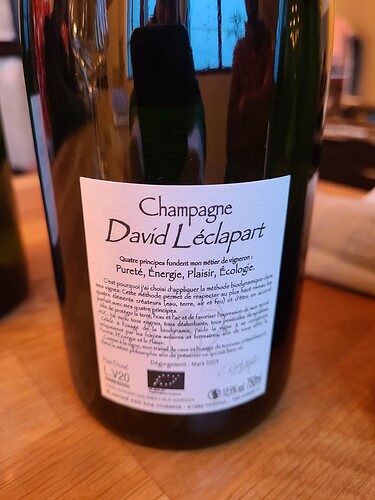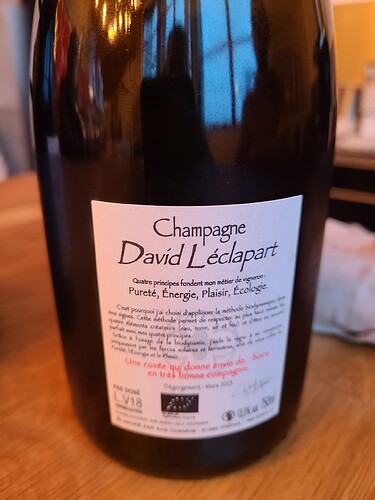Disclaimer: we sell their wines.
Champagne David Léclapart in Trépail (on another gloomy day) – 07/02/2024
Notes: edited for some minor corrections on the history and approach.
I was particularly excited for this visit for two reasons. Primo, I loooove their champagnes. Secundo, I was very much looking forward to discuss their philosophy and approach. While David was in Geneva, his son Martin was nice enough to host us after a full day of work.
Arriving at the tasting room, everything feels authentic: no gimmick, no excess. Martin has a cool vibe to him and he made us feel at ease right from the start. As they haven’t disgorged the latest vintage yet, we were to focus on 3 wines: 2020 Trépail Blanc (Coteaux Champenois), 2020 L’Amateur and the 2018 L’Aphrodisiaque.
We start with the Coteaux and quickly engage with Martin who is clearly very hands-on and knowledgeable about every aspect of the growing and winemaking. They have 3 hectares (about 7.5 acres) of vines in Trépail over 20 parcels and planted to 80% Chardonnay and 20% Pinot Noir. Trépail is a cooler village as it sits in somewhat of a “bowl” (cuvette) and is bordered by forests. They are now the 4th generation to tend the land. 90% of the vineyard is under sélection massale with only one parcel with clones. They have converted to biodynamie in 1998 and have received Demeter certification in 2001. The initial conversion that David went through started with bumps in the road. But after meeting with an Australian expert in biodynamie, he decided to keep away from the dogma in certain books describing the philosophy and make his own path respecting the tenants of it. Since then, it’s working and they wouldn’t veer away from it.
The three pillars of their work are: everything is vintage, no dosage whatsoever and full natural malo on all wines. They work with enameled vats (enameled steel) and some oak (a little bit of oak from Champagne but most coming from Hermitage cooper in Burgundy who own their trees and forests). They get the barrels as new oak but with a “chauffe blonde” (long and low toasting) and their wines in new oak account for only a fraction of their vinification. So, you definitely don’t get oak as a strong note in their wines. They don’t work with stainless steel because their experiences with it provided wines that were thinner. The stainless provides too much constant “energy” to the wines by having it “move around” in the vats. This was the first time I was presented with this empirical observation.
They decide when to pick when the grapes taste ripe, the seeds taste right and the skins feel ready. I love that senses dictate the action. Call me a romantic. They do use the refractometer a bit but not much. They tend to pick about a week to a week and a half later then their neighbours.
The presses are wooden pneumatic Coquard but aren’t in house. They have a partner for that.
They put in bottle (tirage) at 20 g/l instead of the usual 24 g/l. They feel that provides just the right pressure for their wines.
11 months on fine lees and at least 2 years “sur lattes”. There is no bâtonnage, filtration nor fining.
The alcoholic fermentation happens with indigenous yeasts. The chai has a northern exposure, keeping it a little cooler. Nothing is thermo-regulated. The vats aren’t bigger than 40 hl.
They do see the climate change impacts. In 2023, they had to use refrigerated trucks to get the grapes from the field to the sorting and pressing and they now have to start picking at nighttime or very early morning (hello headlamps!).
They have 5 cuvées (L’Amateur, L’Artise, L’Apôtre, L’Astre and L’Aphrodisiaque) and a a full Coteaux lineup (white but not in 2022, red and rosé). They make about 15,000 bottles a year. I asked Martin why most Coteaux champenois wines were pretty expensive and I learned that they have to fit within the appellation Champagne meaning that a bottle of Coteaux is one less bottle of champagne you can produce! The “cahier des charges” also mentions that you cannot blend vintages for your Coteaux which is not an issue at Léclapart since they don’t have reserve wines (see pillar #1 above…). Oh yes, why the “A” for the cuvées you might ask? Because the first letter of the alphabet seemed fitting when David made a “new start” (like the very beginning of something new) with his first cuvées under his name.
About 90% of their production is exported and sold abroad in about 34 different countries.
So, what do you get with David Léclapart champagnes? Wines that reflect the carefully and properly tended land, the vintage conditions, the ripeness of the grapes when picked and gentle and expertly vinified juice. There is not much room for error when everything is that transparent and authentic.
Coteaux Champenois Trépail Blanc 2020
This pours with a pale yellow going to hay color. The nose offers citrus (ripe lime, lemon), a slight vanilla cream whiff and hints of spices and crushed rocks. What really gets you is the texture on this wine. There is good structure to the palate with a clean and bright acidity, nice volume on the mid-palate and a decent mineral finish. It’s defined by the freshness (acidity, minerality) but it’s not lacking fruit to keep this balanced. Good food wine and part of the best white Coteaux I’ve tried.
When I tasted this wine, I don’t know exactly why but Robert-Denogent came to mind. I mentioned this to Martin who knew the domaine and actually had the chance to chat with Antoine in Volnay not long ago. I think we both share an appreciation for their wines.
L’Amateur 2020
Disgorgement of July or September 2023. This comes from 6 parcels varying from year to year (100% Chardonnay). The first nose gave me a bunch of pretty florals, slight autolytic notes a little ripe citrus, ripe apple and pear. The palate is initially a little timid but it builds intensity and provides a nice chalk finish. This is a very nice, understated rendition of Chardonnay. Don’t let the delicate feel of this bottle fool you, there is plenty of complexity and pleasure in this.
L’Aphrodisiaque 2018
Disgorged in November 2023.
The star of the show. 80% Chardonnay and 20% Pinot Noir. This is also 100% in oak barrels. It spends 11 months on fine lees and 4 years sur lattes. This bottle had been opened for 1 week prior to our tasting and… it didn’t suffer one bit! It pours a nice golden yellow. Still a beautiful rich nose with quince, pear, toasted brioche, red berries and a nice punch of spices. There’s great concentration and amplitude on the palate. It’s complex, ever changing and has a wonderful long finish with enough chalky extract for freshness. Grand vin.
It was a wonderful visit. We sometimes forget the luck that we have to be allowed to meet people who truly make an exceptional product. Many thanks to Martin for sharing such a wealth of information and just being a totally gracious host.
